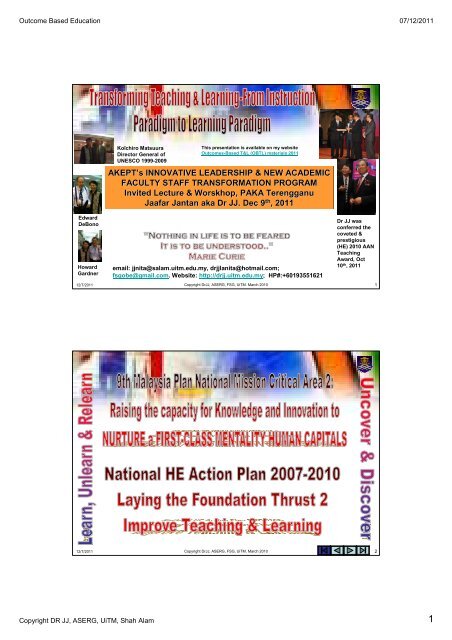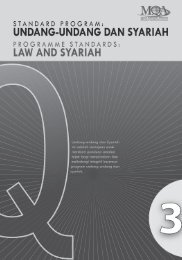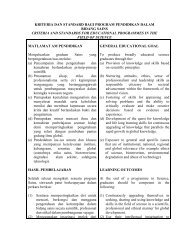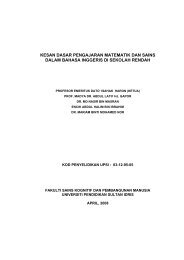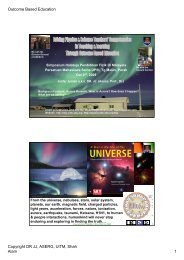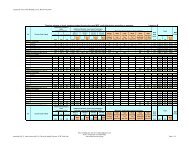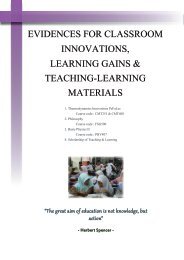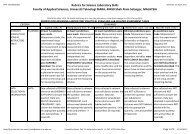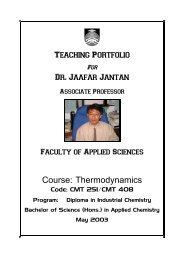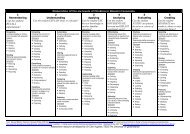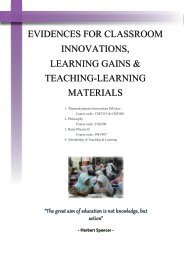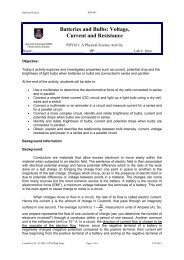AKEPT-Acad. Leadership- 2011 (ppt-pdf) - DrJJ - UiTM
AKEPT-Acad. Leadership- 2011 (ppt-pdf) - DrJJ - UiTM
AKEPT-Acad. Leadership- 2011 (ppt-pdf) - DrJJ - UiTM
You also want an ePaper? Increase the reach of your titles
YUMPU automatically turns print PDFs into web optimized ePapers that Google loves.
Outcome Based Education 07/12/<strong>2011</strong>EdwardDeBonoHowardGardnerKoïchiro MatsuuraDirector General ofUNESCO 1999-2009This presentation is available on my websiteOutcomes-Based T&L (OBTL) materials <strong>2011</strong><strong>AKEPT</strong>’s INNOVATIVE LEADERSHIP & NEW ACADEMICFACULTY STAFF TRANSFORMATION PROGRAMInvited Lecture & Worskhop, , PAKA TerengganuJaafar Jantan aka Dr JJ. Dec 9 th , <strong>2011</strong>email: jjnita@salam.uitm.edu.my, drjjlanita@hotmail.com;fsgobe@gmail.com. Website: http://drjj.uitm.edu.my; HP#:+60193551621Dr JJ wasconferred thecoveted &prestigious(HE) 2010 AANTeachingAward, Oct10 th , <strong>2011</strong>12/7/<strong>2011</strong> Copyright <strong>DrJJ</strong>, ASERG, FSG, <strong>UiTM</strong>. March 2010 112/7/<strong>2011</strong> Copyright <strong>DrJJ</strong>, ASERG, FSG, <strong>UiTM</strong>. March 2010 2Copyright DR JJ, ASERG, <strong>UiTM</strong>, Shah Alam 1
Outcome Based Education 07/12/<strong>2011</strong>http://drjj.uitm.edu.my12/7/<strong>2011</strong> Copyright <strong>DrJJ</strong>, ASERG, FSG, <strong>UiTM</strong>. March 2010 712/7/<strong>2011</strong> Copyright <strong>DrJJ</strong>, ASERG, FSG, <strong>UiTM</strong>. March 2010 8Copyright DR JJ, ASERG, <strong>UiTM</strong>, Shah Alam 4
Outcome Based Education 07/12/<strong>2011</strong>Kuhn argues that scientific advancement is not evolutionary, butrather is a "series of peaceful interludes punctuated by intellectuallyviolent revolutions", and in those revolutions "one conceptual world wview is replaced by another". Kuhn, 1962. The Scientific RevolutionParadigm Shift is a change from one way of thinking toanother. It's a revolution, a transformation, a sortof metamorphosis. . It does not JUST happen, but rather, it isdriven by agents of changehttp://drjj.uitm.edu.my from the Ptolemaic system (the earth at the center of the universe) to theCopernican system (the sun at the center of the universe) from Newtonian physics to Relativity and Quantum Physics.Both movements eventually changed the world view“WE ARE NOT HUMAN BEINGS HAVING A SPIRITUAL EXPERIENCEWE ARE SPIRITUAL BEINGS HAVING A HUMAN EXPERIENCE”12/7/<strong>2011</strong> Copyright <strong>DrJJ</strong>, ASERG, FSG, <strong>UiTM</strong>. March 2010 9http://drjj.uitm.edu.my“A A university is an institution that provides experiences for intenseinteraction between students & teachers” – Syed Naquib quoted byDeputy Minister of HE at the opening of EDUCATE conference, Nikko Hotel,Oct 7 th , 2010One of the most important goals of a university is to developindividuals who have advanced literacy skills in theirdiscipline: people who can participate effectively bycritiquing information and ideas and by contributing withrigour and creativity to new insights and knowledge, whoare self-aware as learners, and who are rhetorically versatile,confident communicators able to adapt and contribute tothe demands of employment and life in a changingsociety and wider world.12/7/<strong>2011</strong> Copyright <strong>DrJJ</strong>, ASERG, FSG, <strong>UiTM</strong>. March 2010 10Copyright DR JJ, ASERG, <strong>UiTM</strong>, Shah Alam 5
Outcome Based Education 07/12/<strong>2011</strong>http://drjj.uitm.edu.myOutcomes-Based Education (OBE)is a philosophy, an approach toeducation based on products oflearning experiencesInvolved Everystakeholders ofhigher educationIntegrates Constructively AlignedTLAs, , Assessment & Grading to theFinished Product, the LearningOutcomesPreparesgraduates asknowledgeable& responsiblecitizens07/12/<strong>2011</strong>Copyright <strong>DrJJ</strong>, ASERG, FSG, <strong>UiTM</strong>. March 2010 11Copyright DR JJ, ASERG, <strong>UiTM</strong>, Shah Alam 6
Outcome Based Education 07/12/<strong>2011</strong>Technical skills1.Knowledge (C)2.Practical Skills (P)3.Thinking and scientificskills (C,P)Professional skills1.Communication skills (P/A)2.Social skills, teamwork andresponsibility (A/P)6.Values, ethics, moral andprofessionalism (A)7.Information management andlifelong learning skills(A/P)8.Managerial and entrepreneurialskills (A/P)9.<strong>Leadership</strong>skills (A/P)Copyright <strong>DrJJ</strong>, ASERG, FSG, <strong>UiTM</strong>. March 2010 13Professional skills1. Critical thinking and problem solving skills (C/P)-LO3)2. Communication skills (P/A)-LO43. Group working skills (P/A)-LO54. Ethics and professionalism (A)-LO65. Lifelong learning and information management (A/P)-LO76. Entrepreneurship skills (A)-LO87. <strong>Leadership</strong> skills (A/P)-LO9Copyright <strong>DrJJ</strong>, ASERG, FSG, <strong>UiTM</strong>. March 2010 14Copyright DR JJ, ASERG, <strong>UiTM</strong>, Shah Alam 7
Outcome Based Education 07/12/<strong>2011</strong>12/7/<strong>2011</strong> Copyright <strong>DrJJ</strong>, ASERG, FSG, <strong>UiTM</strong>. March 2010 17Joseph Rost of University of San Diego is one of the most popularwriters in recognizing the shift from the industrial concept of leadership(leader-centered view) to a paradigm he calls the post-industrialconcept of leadership.He articulates a definition of leadership based on this post-industrialperspective. A definition he believes is more consistent withcontemporary organizational life. Rost's definition says that leadershipis an influence relationship among leaders and followers who intendreal changes that reflect their mutual purposes.12/7/<strong>2011</strong> Copyright <strong>DrJJ</strong>, ASERG, FSG, <strong>UiTM</strong>. March 2010 18Copyright DR JJ, ASERG, <strong>UiTM</strong>, Shah Alam 9
Outcome Based Education 07/12/<strong>2011</strong>12/7/<strong>2011</strong> Copyright <strong>DrJJ</strong>, ASERG, FSG, <strong>UiTM</strong>. March 2010 2312/7/<strong>2011</strong> Copyright <strong>DrJJ</strong>, ASERG, FSG, <strong>UiTM</strong>. March 2010 24Copyright DR JJ, ASERG, <strong>UiTM</strong>, Shah Alam 12
Outcome Based Education 07/12/<strong>2011</strong><strong>DrJJ</strong>, Zollman, Law, TS Zulhttp://drjj.uitm.edu.my Born & Raised in the state of Hang JEBAT… Early education at St. David’s, Science Malacca & SDAR (Seremban) B.Sc. Physics (1983); M.Sc. Condensed Matter (1985) – Kansas St. Univ. Teaching Certificate (1986) – MPTI, Johor Bahru Served ITM – Jan 1987 PhD Physics Education (1991-1994) - Kansas St. Univ. Physics & Education expert (Recipient of <strong>UiTM</strong>’s 2010 T&L <strong>Acad</strong>emic Award) Practiced OBE & Active Learning on my own since 1997. OBE, OBTL workshop speaker, facilitator & consultant at national level Vice-Chair Asian Physics Education Network (ASPEN), UNESCO Chair for ASPEN, Malaysia. Nominated for Innovative Teaching & Learning National & International Active Member, Science Educ. Committee, <strong>Acad</strong>emy Science Malaysia since 2005. Keynote, Plenary and Invited Speaker in Conferences Nationally & Internationally12/7/<strong>2011</strong> Copyright <strong>DrJJ</strong>, ASERG, FSG, <strong>UiTM</strong>. March 2010 25“When I really understand something,it is as if I had discovered it myself “Richard Feynman, Physicist & Nobel laureatein 1965 (Quantum Electrodynamics)Dr JJ’s Teaching PhilosophyJourneytowards Enrichment & BalanceArts& sciences of Teaching& Learningalance utilizingJourneytowardsEnrichmentandBalanceutilizingArts and Sciences inTeaching & LearningCopyright <strong>DrJJ</strong>, ASERG, FSG, <strong>UiTM</strong>. March 2010 26Copyright DR JJ, ASERG, <strong>UiTM</strong>, Shah Alam 13
Outcome Based Education 07/12/<strong>2011</strong>12/7/<strong>2011</strong> Copyright <strong>DrJJ</strong>, ASERG, FSG, <strong>UiTM</strong>. March 2010 2712/7/<strong>2011</strong> Copyright <strong>DrJJ</strong>, ASERG, FSG, <strong>UiTM</strong>. March 2010 28Copyright DR JJ, ASERG, <strong>UiTM</strong>, Shah Alam 14
Outcome Based Education 07/12/<strong>2011</strong>Outcomes& Contenthttp://drjj.uitm.edu.myStudentsSettingTeacher Can there be teaching without students? Can there be teaching when there are students, but no teacher? Can there be teaching without a subject?Teaching involves a teacher and a studentinteracting over a subject in a setting.12/7/<strong>2011</strong> Copyright <strong>DrJJ</strong>, ASERG, FSG, <strong>UiTM</strong>. March 2010 29Outside knowledgeFrom teachers(Direct Instruction),Books & from outsidelearner’s brainFill upInside isEMPTY…So, was it filled??Fill upInside isEMPTY…Let’s Examine them,in writing..Teaching, Learning & Assessment inthe 19 th Century-Instruction Paradigm12/7/<strong>2011</strong> Copyright <strong>DrJJ</strong>, ASERG, FSG, <strong>UiTM</strong>. March 2010 30Copyright DR JJ, ASERG, <strong>UiTM</strong>, Shah Alam 15
Outcome Based Education 07/12/<strong>2011</strong>Outside knowledgeFrom teachers(Direct Instruction),Books & from outsidelearner’s brainFill upInside isEMPTY…So, was it filled??Fill upInside isEMPTY…Let’s Examine them,in writing..Teaching, Learning & Assessment inthe 20 th Century-Instruction Paradigm12/7/<strong>2011</strong> Copyright <strong>DrJJ</strong>, ASERG, FSG, <strong>UiTM</strong>. March 2010 31http://drjj.uitm.edu.my“The greatest enemy of understanding is coverage – I can’t repeatthat often enough. If you’re determined to cover a lot of things, youare guaranteeing that most kids will not understand, becausethey haven’t t had time enough to go into things in depth, to figureout what the requisite understanding is, and be able to performthat understanding in different situations.”(Gardner 1993: 24)Source: Biggs & Tang (2007). “Teaching for Quality Learning at University”. Third Edition. McGraw Hill Companies.12/7/<strong>2011</strong>Copyright <strong>DrJJ</strong>, ASERG, FSG, <strong>UiTM</strong>. March 2010 32Copyright DR JJ, ASERG, <strong>UiTM</strong>, Shah Alam 16
Outcome Based Education 07/12/<strong>2011</strong>Peter Ewell’s argument In his December 1997 AAHE Bulletin article "Organizing forLearning," that the two common flaws in our change strategies that causedassessment NOT leading to learning improvement are:1. initiatives have been implemented without a deep understanding of what"collegiate learning" really means and which strategies are likely to promote it;2. initiatives have, for the most part, been attempted piecemeal within and acrossinstitutions.Most assessment efforts were implemented without a clear vision of what"higher" or "deeper" learning is and without an understanding of howassessment can promote such learning. Our piecemeal attempts stem partlyfrom a mechanistic, additive model of assessment, which needs to be replacedby a transformative assessment-asas-culture-change change model if we’re to make realprogress.Angelo, T. (1999). Doing Assessment As If Learning Matters Most. AAHE Bulletin. May 1999. Accessed Dec 2 nd ,<strong>2011</strong>. http://education.gsu.edu/ctl/outcomes/Doing%20Assessment%20As%20If%20Learning%20Matters%20Most.htm12/7/<strong>2011</strong> Copyright <strong>DrJJ</strong>, ASERG, FSG, <strong>UiTM</strong>. March 2010 35"Although engineering students used memorized formulas successfully ly tosolve physics problems, there were 'widespread misconceptions' whenthey were required to provide 'coherent verbal descriptions of abstract aconcepts‘ inherent in the problems.After watching their teachers work 1,000 problems in class and solving another 3,000themselves outside class, 'after four years, engineering students showed negligibleimprovement in problem-solving skills.“Gardiner, L.F.. “Why We Must Change: The Research Evidence”, Thought and Action,14(1), pp.71-88. Available electronically at http://www2.nea.org/he/heta98/s98pg71.<strong>pdf</strong>.Physics Education Research-Validated Learning evidences since the 1980’sleading to Valid & Reliable Measuring Instruments such as the revolutionaryForce Concept Inventory (FCI) & the inclusion of Physics EducationResearch as a branch of physics & reported in Physical Review SpecialTopics—Physics Education Research12/7/<strong>2011</strong> Copyright <strong>DrJJ</strong>, ASERG, FSG, <strong>UiTM</strong>. March 2010 36Copyright DR JJ, ASERG, <strong>UiTM</strong>, Shah Alam 18
Outcome Based Education 07/12/<strong>2011</strong>Ernest L. Boyer, in his influential book Scholarship Reconsidered: Priorities of theProfessoriate (Carnegie Foundation, 1990), concluded that “the work of the professoriate mightbe thought of as having four separate, yet overlapping, functions. These are: the scholarshipof discovery; the scholarship of integration; the scholarship of application; and the scholarshipof teaching.” This conceptualization of scholarship elevates thetraditional role of teaching from “a a routine function, tacked on” toan essential component of a professor’s s scholarly life.Furthermore, Boyer argued that the academy should recognize andreward all four components of scholarship, including thescholarship of teaching.Ernest L. Boyer. (1990). Scholarship Reconsidered: Priorities of theProfessoriate (Carnegie Foundation, 1990). Boyer was then the president of theCarnegie Foundation for the Advancement of Teaching.http://cft.vanderbilt.edu/teaching-guides/reflecting/sotl/#what112/7/<strong>2011</strong> Copyright <strong>DrJJ</strong>, ASERG, FSG, <strong>UiTM</strong>. March 2010 3712/7/<strong>2011</strong> Copyright <strong>DrJJ</strong>, ASERG, FSG, <strong>UiTM</strong>. March 2010 38Copyright DR JJ, ASERG, <strong>UiTM</strong>, Shah Alam 19
Outcome Based Education 07/12/<strong>2011</strong>Diagram of a neuron. Picture from Wikipedia(http://en.wikipedia.org/wiki/Neuron)http://www.human-memory.net/brain_neurons.htmlScience of LearningPsychology-NeurosciencesSynaptic transmission. Picture from Wikipedia(http://en.wikipedia.org/wiki/Chemical_synapse)12/7/<strong>2011</strong> Copyright <strong>DrJJ</strong>, ASERG, FSG, <strong>UiTM</strong>. March 2010 39KeyMemorySystems& HowtheyInteractBufferingRAMStorage Media12/7/<strong>2011</strong> Copyright <strong>DrJJ</strong>, ASERG, FSG, <strong>UiTM</strong>. March 2010 40Copyright DR JJ, ASERG, <strong>UiTM</strong>, Shah Alam 20
Outcome Based Education 07/12/<strong>2011</strong>KeyMemorySystems& HowtheyInteractACTIVITY: READ& REMEMBERTHE NUMBERShort term or Working Memory1-30 secs DurationLimited to 7+2 independent chunksLong Term MemoryMinutes to Lifetime RecallRote & Meaningful Learning Continuum21066121066119571963456201938496612618621321162112/7/<strong>2011</strong> Copyright <strong>DrJJ</strong>, ASERG, FSG, <strong>UiTM</strong>. March 2010 41Five Themes that Changed Conceptions of Learning. Summary of the book“HOW PEOPLE LEARN”• Experts notice features and meaningful patterns of information that are not noticed bynovices.• Experts have acquired a great deal of content knowledge that is organized, andtheir organization of information reflects a deep understanding of the subjectmatter.• Experts' knowledge cannot be reduced to sets of isolated facts or propositionsbut, instead, reflects contexts of applicability, i.e., it is ''conditionalizedconditionalized."• Experts are able to retrieve important aspects of their knowledge e with littleattentional effort.• Though experts know their disciplines thoroughly, this does not guarantee thatthey are able to instruct others about the topic.• Experts have varying levels of flexibility in their approaches to new situations.Source: John D. Bransford, Ann L. Brown, & Rodney C. Cooking, Editors (1999). “How People Learn: Brain,Mind, Experience, and School”. Committee Developments in the Science of Learning. Commission on SocialSciences & Education, National Research Council. National <strong>Acad</strong>emics Press.12/7/<strong>2011</strong> Copyright <strong>DrJJ</strong>, ASERG, FSG, <strong>UiTM</strong>. March 2010 42Copyright DR JJ, ASERG, <strong>UiTM</strong>, Shah Alam 21
Outcome Based Education 07/12/<strong>2011</strong>“The most important single factor influencinglearning is what the learner already knows.Ascertain this and teach him accordingly.“David Ausubel, 1968.Inside isNOTEMPTY…CONSTRUCTIVISM –Knowledge is to beconstructed..GET THE INSIDE OUT SO THATTHE OUTSIDE CAN GO IN..Inside isNOTEMPTY…Science of LearningPsychology-Neurosciences12/7/<strong>2011</strong> Copyright <strong>DrJJ</strong>, ASERG, FSG, <strong>UiTM</strong>. March 2010 4312/7/<strong>2011</strong> Copyright <strong>DrJJ</strong>, ASERG, FSG, <strong>UiTM</strong>. March 2010 44Copyright DR JJ, ASERG, <strong>UiTM</strong>, Shah Alam 22
Outcome Based Education 07/12/<strong>2011</strong>GET THE INSIDE OUT SO THATTHE OUTSIDE CAN GO IN..Fantasia ie, , illusory understanding orpersistent misconceptions. Potentially farmore insidious than amnesia. Can bedangerous. The state in which studentsare absolutely confident that theyunderstand something, but they don't.Inside isNOTEMPTY…Inside isNOTEMPTY…Existing Knowledge Could beMisconceivedAristotelianInhibits learning newknowledgeScience of LearningPsychology-Neurosciences12/7/<strong>2011</strong> Copyright <strong>DrJJ</strong>, ASERG, FSG, <strong>UiTM</strong>. March 2010 45The five bulbs are identical and the batteries are identicaland ideal. Rank the five bulbs from brightest to dimmest.Explain your reasoning.McDermott & Shaffer at the Univ of Washington administered to more than1000 students. Only 15% correct pre/post response , samples are fromintroductory calculus-based physics courses. PhD students – 70 % correctresponses12/7/<strong>2011</strong> Copyright <strong>DrJJ</strong>, ASERG, FSG, <strong>UiTM</strong>. March 2010 46Copyright DR JJ, ASERG, <strong>UiTM</strong>, Shah Alam 23
Outcome Based Education 07/12/<strong>2011</strong>The five bulbs are identical andthe batteries are identical andideal. Rank the five bulbs frombrightest to dimmest. Explainyour reasoning.McDermott at Univ of Washington.Administered to more than 1000students. 0 % correct pre/postresponse , samples are fromintroductory calculus-based physicscourses.12/7/<strong>2011</strong> Copyright <strong>DrJJ</strong>, ASERG, FSG, <strong>UiTM</strong>. March 2010 47Scores fromoverseasUSA27% - 73%Scores from Malaysian Public Universities (<strong>DrJJ</strong>’s unpublishedwork)Overall for ALL bumi: 21.3%(N=1792). Overall for nonbumi:27.4% (N=308).UKM (N=177) overall: 22.3%Bumi: 20%; Non-bumi: 30%UPSI (N=414) overall: 20.1%(T-test at the 95%confidence shows nosignificant difference inscores between bumi &non-bumi)UK28% - 33%Finland: 45.7 %Russia: 46.5 %USM: 36.6%Bumi: 25%; Non-bumi: 40%UPM: 21%, * 23%<strong>UiTM</strong> (N=1343) overall:21.4%<strong>UiTM</strong>’s American DegreeFoundation Program(N=47) overall: 38%Copyright DR JJ, ASERG, <strong>UiTM</strong>, Shah Alam 24
Outcome Based Education 07/12/<strong>2011</strong>Table of Frequency of Malaysian university students showingcompetency (score ≥60%) in FCI.N=2100. Only 1% scored at and above competencyScore76%73%70%67%60%60%Frequency313344Univ<strong>UiTM</strong> ADP (bumi)UKM (non-bumi)(non-bumi)USM (bumi)USM (non-bumi)<strong>UiTM</strong> ADP (bumi)A truck broke down and received a push from behind by a small caras shown by the figure below.15. As the car accelerated to attain a constant speed;12/7/<strong>2011</strong> Copyright <strong>DrJJ</strong>, ASERG, FSG, <strong>UiTM</strong>. March 2010 50Copyright DR JJ, ASERG, <strong>UiTM</strong>, Shah Alam 25
Outcome Based Education 07/12/<strong>2011</strong>(A) the force exerted by the car onto the truck is thesame as the force exerted by the truck onto the car.(B) the force exerted by the car onto the truck is smallerthan the force exerted by the truck onto the car.(C) the force exerted by the car onto the truck is biggerthan the force exerted by the truck onto the car.12/7/<strong>2011</strong> Copyright <strong>DrJJ</strong>, ASERG, FSG, <strong>UiTM</strong>. March 2010 51Comparing Pre (N=1354) & Posttest (N=1145) FCI change in scores forquestion 15 . Answer is A.80%70%60%50%40%30%20%Pre APost APre BPost BPre CPost CPre DPost DPre EPost E10%0%Pre A Post A Pre B Post B Pre C Post C Pre D Post D Pre E Post EAnswer Options for P re & P ost Test12/7/<strong>2011</strong> Copyright <strong>DrJJ</strong>, ASERG, FSG, <strong>UiTM</strong>. March 2010 52Copyright DR JJ, ASERG, <strong>UiTM</strong>, Shah Alam 26
Outcome Based Education 07/12/<strong>2011</strong>CRI 0 = have no clueCRI 5 = very certainCRI=2,3Bef:61%, Aft:37%Bef:9%, Aft:10%Bef:15%, Aft:23%Bef:9%, Aft:13%Bef:6%, Aft:17%12/7/<strong>2011</strong> Copyright <strong>DrJJ</strong>, ASERG, FSG, <strong>UiTM</strong>. March 2010 53Transform1980: Dude, look at how savvy I was..boombox, Betamax camcorder,,calculator, cassette tape player,2010: IPHONENo wonder I lack the strength ¬ developing the good-lookingmuscles…12/7/<strong>2011</strong> Copyright <strong>DrJJ</strong>, ASERG, FSG, <strong>UiTM</strong>. March 2010 54Copyright DR JJ, ASERG, <strong>UiTM</strong>, Shah Alam 27
Outcome Based Education 07/12/<strong>2011</strong>Transform1980: 20 GB data storage weighing 2Megagrams & computer I used in 19862010: Jaw DroppersSamsung Mobile DevicesSony 1 TeraBytes Memory Cardwith 5 Gbps data transfer12/7/<strong>2011</strong> Copyright <strong>DrJJ</strong>, ASERG, FSG, <strong>UiTM</strong>. March 2010 55Outside knowledgeFrom teachers(Direct Instruction),Books & from outsidelearner’s brainFill upInside isEMPTY…So, was it filled??Fill upInside isEMPTY…Let’s Examine them,in writing..Present Day Teaching, Learning &Assessment??12/7/<strong>2011</strong> Copyright <strong>DrJJ</strong>, ASERG, FSG, <strong>UiTM</strong>. March 2010 56Copyright DR JJ, ASERG, <strong>UiTM</strong>, Shah Alam 28
Outcome Based Education 07/12/<strong>2011</strong>12/7/<strong>2011</strong> Copyright <strong>DrJJ</strong>, ASERG, FSG, <strong>UiTM</strong>. March 2010 57“Learning is not a spectator sport.You do not learn much just sitting in classes listeningto teachers, memorizing prepackaged assignments,and spitting out answers. You must talk about whatyou are learning, write reflectively about it, relate it topast experiences, and apply it to your daily lives. Youmust make what you learn part of yourselves.”-Source:"Implementing the Seven Principles:Technology as Lever" by Arthur W. Chickeringand Stephen C. Ehrmann12/7/<strong>2011</strong>Copyright <strong>DrJJ</strong>, ASERG, FSG, <strong>UiTM</strong>.March 2010 58Copyright DR JJ, ASERG, <strong>UiTM</strong>, Shah Alam 29
Outcome Based Education 07/12/<strong>2011</strong>12/7/<strong>2011</strong> Copyright <strong>DrJJ</strong>, ASERG, FSG, <strong>UiTM</strong>. March 2010 5912/7/<strong>2011</strong> Copyright <strong>DrJJ</strong>, ASERG, FSG, <strong>UiTM</strong>. March 2010 60Copyright DR JJ, ASERG, <strong>UiTM</strong>, Shah Alam 30
Outcome Based Education 07/12/<strong>2011</strong>12/7/<strong>2011</strong> Copyright <strong>DrJJ</strong>, ASERG, FSG, <strong>UiTM</strong>. March 2010 61JourneytowardsEnrichmentandBalanceutilizingArts and Sciences inTeaching & Learning12/7/<strong>2011</strong>Copyright <strong>DrJJ</strong>, ASERG, FSG, <strong>UiTM</strong>. March 2010 62Copyright DR JJ, ASERG, <strong>UiTM</strong>, Shah Alam 31
Outcome Based Education 07/12/<strong>2011</strong> Reasoning develops sequentially & gradually Begins with sensory-motor to preoperational reasoning (worldview lackscausal reasoning & ego controls the reasoning) Beyond 9 years old, the worldview of a person goes from concrete toformal operational reasoningIn concrete reasoning, a person Needs reference to familiar objects, actions & observables properties Uses classification, serial ordering, conservation & one-to-onecorrespondence in relation to concrete items abobe Need step-by-step instruction to a lenghty procedure Is not aware of his own reasoning, inconsistencies among varios statementsor contradictions with other known facts12/7/<strong>2011</strong> Copyright <strong>DrJJ</strong>, ASERG, FSG, <strong>UiTM</strong>. March 2010 63In formal reasoning, a person Can reason with concepts, relationship, abstract properties, axioms &theories, Uses symbols to express ideas Applies, combinatorial, classification, conservation, serial orderingand proportional reasoning in these abstract modes of reasoning Can plan lengthy procedure to attain the given overall goals &resources Is aware of, and critical of, his own reasoningand actively checks onthe validity of his own conclusion by appealing to other information12/7/<strong>2011</strong> Copyright <strong>DrJJ</strong>, ASERG, FSG, <strong>UiTM</strong>. March 2010 64Copyright DR JJ, ASERG, <strong>UiTM</strong>, Shah Alam 32
Outcome Based Education 07/12/<strong>2011</strong>Level 1BlameStudentsLevel 2Blame Teachershttp://drjj.uitm.edu.myPictures from the VideoUnderstand Understanding &Teach TeachingLevel 2 Level 312/7/<strong>2011</strong>Copyright <strong>DrJJ</strong>, ASERG, FSG, <strong>UiTM</strong>. March 2010 65Source: Felder.,R.M., Brent, Rebeca (2003).Designing and Teaching Courses to Satisfythe ABET Engineering Criteria. Journal ofEngineering Education, 92 (1), 7-25StudentsCONSTRUCTMEANING fromwhat they learnCurriculum isdesigned so thatthe learningactivities andassessmenttasks are alignedwith the learningoutcomes thatare intended inthe course.12/7/<strong>2011</strong>Copyright <strong>DrJJ</strong>, ASERG, FSG, <strong>UiTM</strong>. March 2010 66Copyright DR JJ, ASERG, <strong>UiTM</strong>, Shah Alam 33
Outcome Based Education 07/12/<strong>2011</strong>KNOW your LEARNERSLearning PreferencesLearning Styles"...a biologically and developmentally imposed set ofpersonal characteristics that make the sameteaching method effective for some students andineffective for others,..." (Dunn, Beaudry, andKlavas, 1989)12/7/<strong>2011</strong>Copyright <strong>DrJJ</strong>, ASERG, FSG, <strong>UiTM</strong>. March 2010 67What makes meaningful learning difficult??-Learning PreferencesFelder’s s Model - 4 domains of informationhandling: to understand new knowledgeInputUnderstoodNewknowledgeProcessedPerceivedILS12/7/<strong>2011</strong>Copyright <strong>DrJJ</strong>, ASERG, FSG, <strong>UiTM</strong>. March 2010 68Copyright DR JJ, ASERG, <strong>UiTM</strong>, Shah Alam 34
Outcome Based Education 07/12/<strong>2011</strong>Student’ Learning Preferences:Information Handling Domains Felder’s)VisualVerbal*USA findings, ** DR. J.J’s s (N = 1122)Input*69, ** 87prefer charts, diagrams andpictures.*30, ** 13prefer the spoken or writtenword.Sensingprefer data and facts. like facts &solve well establish methods,resent being tested on materialsthat has not been explicitlycovered in classIntuitivePerception*57, ** 58*42, ** 42prefer theories & interpretations offactual information.12/7/<strong>2011</strong>ILSILS-ACopyright <strong>DrJJ</strong>, ASERG, FSG, <strong>UiTM</strong>. March 2010 69Student’ Learning Preferences:Information Handling Domains Felder’s)*USA findings, ** DR J.J.’s s (N = 1122)ProcessingUnderstandingActive*67, **60Sequential*71, ** 60learn best by doingsomething physicalwith the informationReflective*32, ** 40do the processing intheir headseasily make linear connections betweenindividual stepsGlobal*28, ** 40must get “big picture” before individualpieces fall into place12/7/<strong>2011</strong>Copyright <strong>DrJJ</strong>, ASERG, FSG, <strong>UiTM</strong>. March 2010 70Copyright DR JJ, ASERG, <strong>UiTM</strong>, Shah Alam 35
Outcome Based Education 07/12/<strong>2011</strong>Instrument: LSRTS – Q3Gambar dalam Rajah 1 mewakili dua silinder yang mempunyai bentuk dan saizyang sama. Kedua-dua silinder tersebut mengandungi jumlah air yang samabanyaknya. Apabila sebiji guli kaca di jatuhkan dan di biarkan tenggelam didalam Silinder 1, paras air dalam silinder 1 meningkat hingga ke aras-6 silindertersebut.Sekiranya sebiji bebola besi yang sama saiz tetapi lebih berat dari bebola kacadijatuhkan ke dalam silinder 2, air dalam silinder tersebut akan naika. ke aras yang sama dengan Silinder 1.b. ke aras yang lebih tinggi daripada Silinder 1.c. ke aras yang lebih rendah daripada Silinder 1.Guli kaca6Guli besi12/7/<strong>2011</strong>You chose:A: 24%B: 76%You chose:A: 19%B: 78%Silinder 1 Silinder 2Rajah 1Copyright <strong>DrJJ</strong>, ASERG, FSG, <strong>UiTM</strong>. March 2010 71Instrument: LSRTS – Q4Jawapan di atas dipilih keranaa Guli besi akan tenggelam lebih cepat.b. Guli-guli tersebut diperbuat daripada bahan-bahan berlainan.c. Guli besi lebih berat daripada guli kaca.d. Guli kaca menghasilkan tekanan lebih rendah.e. Kedua-dua guli bersaiz sama.Guli kacaGuli besiYou chose:A: 3%B: 9%C: 57%D: 11%E: 20%You chose:A: 0%B: 9%C: 64%D: 7%E: 19%6Silinder 1 Silinder 2Rajah 112/7/<strong>2011</strong>Copyright <strong>DrJJ</strong>, ASERG, FSG, <strong>UiTM</strong>. March 2010 72Copyright DR JJ, ASERG, <strong>UiTM</strong>, Shah Alam 36
Outcome Based Education 07/12/<strong>2011</strong>Post Secondary (Tertiary) Learning-Centered Teachers:1. Have relevant educational, employment-related, technical and otherexpertise in designing and creating learning options that meet the tneeds oflearners.2. Clearly articulate learning outcomes for students.3. Demonstrate well-developed interpersonal skills in their mutually respectfulrelationships with learners.4. Create supportive, collaborative environments for learning.5. Guide, coach, and mentor learners throughout the learning process.6. Understand learning theories and use innovative practices when designing dlearning options, activities and methodologies.7. Maintain and continuously update the relevancy of their content/disciplineexpertise.8. Participate in continuous self-assessment based on feedback from studentsand colleagues.12/7/<strong>2011</strong> Copyright <strong>DrJJ</strong>, ASERG, FSG, <strong>UiTM</strong>. March 2010 73http://drjj.uitm.edu.myIf you are, you breath.If you breath, you talk.WIS-DOMIf you learn, you grow.If you grow, you wish.If you wish, you find.If you talk, you ask.If you ask, you think.If you think, you search.If you search, you experience.If you experience, you learn.If you find, you doubt.If you doubt, you question.If you question, you understand.If you understand, you know.If you know, you want to know more…And if you want to know more,And if you want to know more, you are alive.Video courtesy of National Geographic Channel07/12/<strong>2011</strong>Copyright <strong>DrJJ</strong>, ASERG, FSG, <strong>UiTM</strong>. March 2010 74Copyright DR JJ, ASERG, <strong>UiTM</strong>, Shah Alam 37
Outcome Based Education 07/12/<strong>2011</strong>1. Choose your group members.2. Get acquainted. Helloooo Partner…3. Choose ONE of the 5 T&L CAPs strategic objectives.4. Explain your strategic planning to Initiate, Execute, Assess,Evaluate and Improve the T&L in your own classroom, programor faculty.5. Appoint a speaker or speakers6. Present your outcomes to the learning community.“The one real goal of education is to leave a personasking questions.” Max Beerbohm12/7/<strong>2011</strong> Copyright <strong>DrJJ</strong>, ASERG, FSG, <strong>UiTM</strong>. March 2010 7507/12/<strong>2011</strong>Copyright <strong>DrJJ</strong>, ASERG, FSG, <strong>UiTM</strong>. March 2010 76Copyright DR JJ, ASERG, <strong>UiTM</strong>, Shah Alam 38
Outcome Based Education 07/12/<strong>2011</strong>http://drjj.uitm.edu.myTeacher-centered versus Learner-centered (from Huba & Freed (2000).Domain:Knowledge:Student participation:Role of professor:Role of Assessment:Emphasis:Assessment method<strong>Acad</strong>emic culture:Teacher-centeredTransmitted by instructorPassiveLeader/authorityFew tests—mainly for gradingLearning correct answersUnidimensional testingIndividualistic andcompetitiveLearner-centeredConstructed by studentsActiveFacilitator/learning partnerMany tests—for ongoing feedbackDeveloping deeper understandingMultidimensional productsCollaborative and supportiveSource: Tools and Techniques for course improvement: A handbook for course review and assessment of Student learningCompiled, adapted, and edited by Richard Frye Gary R. McKinney Joseph E. Trimble12/7/<strong>2011</strong> Copyright <strong>DrJJ</strong>, ASERG, FSG, <strong>UiTM</strong>. March 2010 77Thinking about Teaching Level 3: SCL-What the student does..http://drjj.uitm.edu.my What the student does and how that relates to teaching. Teaching supporting learning. Nolonger is it possible to say: ‘I I taught them, but they didn’t t learn.’ Expert teaching includesmastery over a variety of teaching techniques, but unless learning ng takes place, theyare irrelevant; the focus is on what the student does and on how well the intendededoutcomes are achieved. This implies a view of teaching that is not just about facts, concepts and principles to becovered and understood, but also to be clear about:1. What it means to ‘understand’ content in the way that is stipulated in the intendedlearning outcomes.2. What kind of teaching/learning activities are required to achieve e those stipulatedlevels of understanding. Then follow the key questions:1. How do you define those levels of understanding as outcome statements?2. What do students have to do to reach the level specified?3. What do you have to do to find out if the outcomes have been reached at theappropriate level or not?Source: Biggs & Tang (2007). “Teaching for Quality Learning at University”. Third Edition. McGraw Hill Companies.12/7/<strong>2011</strong>Copyright <strong>DrJJ</strong>, ASERG, FSG, <strong>UiTM</strong>. March 2010 78Copyright DR JJ, ASERG, <strong>UiTM</strong>, Shah Alam 39
Outcome Based Education 07/12/<strong>2011</strong>http://drjj.uitm.edu.my“Deliberate and focused instructional design requires us asteachers and curriculum writers to make an important shift inour thinking about the nature of our job. The shift involvesthinking a great deal, first, about the specific learning sought,and the evidence of such learning, before thinking about whatwe, as the teacher, will do or provide in teaching and learningactivities. . Though considerations about what to teach and howto teach it may dominate our thinking as a matter of habit, thechallenge is to focus first on the desired learning from whichappropriate teaching will logically follow”Source: Understanding by Design by Grant Wiggins and Jay McTighe12/7/<strong>2011</strong> Copyright <strong>DrJJ</strong>, ASERG, FSG, <strong>UiTM</strong>. March 2010 79Quote taken from Mike Lamberts’21 st Century Learners - and their approaches to learning“Very often … ignorance of the way to learn, morethan the effort of learning itself, breaks the spirit ofthose who are anxious to do so.”Alberti: 15th century painter and writer12/7/<strong>2011</strong> Copyright <strong>DrJJ</strong>, ASERG, FSG, <strong>UiTM</strong>. March 2010 80Copyright DR JJ, ASERG, <strong>UiTM</strong>, Shah Alam 40
Outcome Based Education 07/12/<strong>2011</strong>http://drjj.uitm.edu.myAssessing declarativeknowledge:Essay examinationsMultiple choice questionsOpen-book examinationsClosed-book examinationsTests and quizzesAssignmentsOrdered outcome itemsLetter to a friendPresentationsAssessing functioningknowledge:Projects (individual)Projects (group)PortfoliosPracticumsLaboratoriesReflective journalsCase studiesPresentationsAssignmentsRapid assessmentsmethods (for largeclasses):Concept mapsVenn diagramsThree-minute essaysGobbetsSource: Biggs & Tang (2007). “Teaching for Quality Learning at University”. Third Edition. McGraw Hill Companies.Copyright <strong>DrJJ</strong>, ASERG, FSG, <strong>UiTM</strong>. March 2010 8112/7/<strong>2011</strong>Copyright <strong>DrJJ</strong>, ASERG, FSG, <strong>UiTM</strong>. March 2010 82Copyright DR JJ, ASERG, <strong>UiTM</strong>, Shah Alam 41
Outcome Based Education 07/12/<strong>2011</strong>SYLLTestLabA “C” student’s s response could be:Forces are agents of change. Physically, a force can bevisually observed as changing the position of a stationaryobject or changing either the speed or the direction orboth if the object was initially in motion.12/7/<strong>2011</strong>An “A” student’s s response: Aslike a “C” student plusNewton’s laws of motion bestdescribes how these changesoccur. In fact, he asserts thatforces cause an object’sposition and hence its speed tochange. Prolong and constantexertion of the force will causea constant change of its speedor direction or both. But in theworld of atoms and subatomicparticles, Newton’s laws beginto breakdown especially atspeeds close to the speed oflight… In addition to visibleforces, invisible forces alsoexist. …. & moreCopyright <strong>DrJJ</strong>, ASERG, FSG, <strong>UiTM</strong>. March 2010 83Assessment gives us essential information about what ourstudents are learning and about thestudentsand about the extent to whichwe are meeting our teaching goals.But the true power of assessment comes in also using it to givefeedback to our students. Improving the quality oflearning in our courses involves not just determining to whatextent students have mastered course content at the end ofthe course; improving the quality of learning also involvesdetermining to what extent students are masteringcontent throughout the coursethe course.SOURCE: Excerpted from National Institute for Science Education (2001b)07/12/<strong>2011</strong> Copyright <strong>DrJJ</strong>, ASERG, FSG, <strong>UiTM</strong>. March 2010 84Copyright DR JJ, ASERG, <strong>UiTM</strong>, Shah Alam 42
Outcome Based Education 07/12/<strong>2011</strong>QuantitativeDirect Evidencecompelling case for the extent to whichstudents have achieved expectedlearning outcomes gathered throughfaculty’s systematic analysis of studentprojects, exams, or sets of specifiedcourse assignments. Entrance Diagnostic Exams Standardized Tests Faculty-made tests Collegiate Learning Assessment Faculty/Program developed Exit ExamIndirectEvidenceself-perceptions oftheir learning andtheir perspectives onprogram structureand curricularcontentCourse Grades07/12/<strong>2011</strong>Copyright <strong>DrJJ</strong>, ASERG, FSG, <strong>UiTM</strong>. March 2010 8507/12/<strong>2011</strong>QualitativeDirect EvidenceDirect Evidencecompelling case for the extent to whichstudents have achieved expected learningoutcomes gathered through faculty’ssystematic analysis of student projects,exams, or sets of specified courseassignments.Capstone coursesPortfolio-faculty created “program portfolios”- samples of students’ work for each learningoutcomes. (course assignments, examquestions, entire tests, in-class activities,fieldwork , activities, and/or homeworkassignment) from selected courses,Indirect Evidenceself-perceptions of theirlearning and theirperspectives onprogram structure andcurricular content Surveys (Exit,Alumni) Exit Interviews Focus GroupCopyright <strong>DrJJ</strong>, ASERG, FSG, <strong>UiTM</strong>. March 2010 86Copyright DR JJ, ASERG, <strong>UiTM</strong>, Shah Alam 43
Outcome Based Education 07/12/<strong>2011</strong>ContinuousOn-going during learning / teaching.Not about giving many quizzes or tests but to use of a variety ofassessment instruments, assessing various components oflearning, not only the thinking processes but including behaviours,personality traits and manual dexterity. PLOs attainment fromcourses are formative data to the program assessmentDiagnosticProvides feedback to students and teachers onstrengths and areas for improvementDifficultiesMisconceptionsRemedialProvides opportunities for modification / improvement07/12/<strong>2011</strong>Copyright <strong>DrJJ</strong>, ASERG, FSG, <strong>UiTM</strong>. March 2010 87 TerminalAt the end of learning / teachingDescriptiveHow well materials / knowledge / skills have been learned For ranking and selection No provision for modification / improvement07/12/<strong>2011</strong>Copyright <strong>DrJJ</strong>, ASERG, FSG, <strong>UiTM</strong>. March 2010 88Copyright DR JJ, ASERG, <strong>UiTM</strong>, Shah Alam 44
Outcome Based Education 07/12/<strong>2011</strong>07/12/<strong>2011</strong> Copyright <strong>DrJJ</strong>, ASERG, FSG, <strong>UiTM</strong>. March 2010 89My dear EF, it has been a while since we last wrote to each other. So, I decide toenlighten you with an interesting character I met today..He puts on a contagious smile and his outlook is quite dashing I must say.. But whatI really wanted to share with you today is the new and interesting ng learningexperience I had while with him… Oh, did I mention that he knows CK??... Will writeto you about that in another letter..As he was talking about MQF, he put up these words that were circled cled andconnected these words with other words.. He claimed the linking between thesewords, a term he coined proposition is a very strong visual representation esentation of what isin our mind. He indicated the similarity and difference between this so calledknowledge representation with the mind map. I wasn’t’ quite sure what it all meantand then it struck me like a lightning bolt how these very familiar iar terms I had alwaysargued with you. Amazingly, they were linked up smoothly in this visualrepresentation called Concept Map….. Linking 2 terms or concepts together byusing linkwords not only clarify the connection between them but also appeared tobe a scientific claim of some sort..07/12/<strong>2011</strong> Copyright <strong>DrJJ</strong>, ASERG, FSG, <strong>UiTM</strong>. March 2010 90Copyright DR JJ, ASERG, <strong>UiTM</strong>, Shah Alam 45
Outcome Based Education 07/12/<strong>2011</strong>http://drjj.uitm.edu.my"Effective teaching is not a set of generic practices, , butinstead is a set of context-driven decisions about teaching.Effective teachers do not use the same set of practices forevery lesson . . . Instead, what effective teachers do isconstantly reflect about their work, observe whether studentsare learning or not, and, then adjust their practiceaccordingly”Source: Glickman, C. (1991). Pretending not to know what we know. Educational <strong>Leadership</strong>, 48(8), 4-1012/7/<strong>2011</strong> Copyright <strong>DrJJ</strong>, ASERG, FSG, <strong>UiTM</strong>. March 2010 91• Active learning refers to students DOING something includingdiscovering, processing, and applying information• Active learning "derives from two basic assumptions: (1) thatlearning is by nature an active endeavor and (2) that differentpeople learn in different ways" (Meyers and Jones, 1993).• The elements of active learning are talking and listening, writing,reading, and reflecting (Meyers and Jones, 1993).12/7/<strong>2011</strong> Copyright <strong>DrJJ</strong>, ASERG, FSG, <strong>UiTM</strong>. March 2010 92Copyright DR JJ, ASERG, <strong>UiTM</strong>, Shah Alam 46
Outcome Based Education 07/12/<strong>2011</strong>•Linguistic intelligence•Logical-mathematical intelligence•Musical intelligence•Bodily-kinesthetic intelligence•Spatial intelligence•Interpersonal intelligence•Intrapersonal intelligencestudentsthink and learn in many different ways. It also provides“... the theory validates educators' everyday experience: studentseducators with a conceptual framework for organizing and reflectingon curriculum, assessment and pedagogical practices. In turn, thisreflection has led many educators to develop new approaches thatmight better meet the needs of the range of learners in theirclassrooms.”Source: Educators in support of the 7 MI proposed by Howard Gardner12/7/<strong>2011</strong> Copyright <strong>DrJJ</strong>, ASERG, FSG, <strong>UiTM</strong>. March 2010 93http://oregonstate.edu/instruct/coursedev/models/id/taxonomy/#table12/7/<strong>2011</strong>Copyright <strong>DrJJ</strong>, ASERG, FSG, <strong>UiTM</strong>. March 2010 94Copyright DR JJ, ASERG, <strong>UiTM</strong>, Shah Alam 47
Outcome Based Education 07/12/<strong>2011</strong>Usethis listforYourCLO &LLO12/7/<strong>2011</strong>Copyright <strong>DrJJ</strong>, ASERG, FSG, <strong>UiTM</strong>. March 2010 95Triarchic Theory of Intelligence (2003)‘Intelligence is the cognitive ability of an individual to learn fromexperience, to reason well, to remember important information, and atocope with the demands of daily living’.Analytical intelligence, creative intelligence, practical intelligenceigence“IQ tests are convenient partial operationalizations of the constructof intelligence, and nothing more. They do not provide the kind ofmeasurement of intelligence that tape measures provide of height. Theymeasure intelligence related to “book smart”..”“Giftednessshould be examined in a broader way incorporating otherparts of intelligence such as creativity ie “street smart”Robert Sternberg, Yale Psychology Professor & President of the AmericanPsychological Association12/7/<strong>2011</strong>Copyright <strong>DrJJ</strong>, ASERG, FSG, <strong>UiTM</strong>. March 2010 96Copyright DR JJ, ASERG, <strong>UiTM</strong>, Shah Alam 48
Outcome Based Education 07/12/<strong>2011</strong>Good Retail Experience• Friendly• Approachable• Good Listener• Caring• Knowledgeable• Took Time• Reflective• Concerned• Responsive• Above &Beyond• Self Confident• Took Ownership• Cheerful• Helpful• Insightful• Accommodating• Personable• Visionary• Humorous• Kind• Appreciative• Goodcommunicator• Clear, precise(communication)• Hard worker• EmpatheticGood Boss• Good teambuilder• Positive• Ethical• Results-oriented (vs.process)12/7/<strong>2011</strong>Copyright <strong>DrJJ</strong>, ASERG, FSG, <strong>UiTM</strong>. March 2010 99Bad Retail Experience• Rude• Headstrong• Insensitive• Closed• Unhelpful• Unprofessional• Unconcerned• Untrained• Incompetent• Unethical• Lazy / Bored• Blame others• Smarmy• Arrogant• Condescending• Non-responsive• Disrespectful• Belligerent• Demeaning• Moody• Negative• Unethical• Incompetent• DiscouragingBad Boss• Self-absorbed• Inconsistentdirection• Vindictive• Ego-maniac• Prideful• Manipulative• Paranoid12/7/<strong>2011</strong>Copyright <strong>DrJJ</strong>, ASERG, FSG, <strong>UiTM</strong>. March 2010 100Copyright DR JJ, ASERG, <strong>UiTM</strong>, Shah Alam 50
Outcome Based Education 07/12/<strong>2011</strong>Good Retail Experience• Satisfied• You wereimportant• Valued• Customer for life• Relieved• Pleasant• Open• Grateful• Impressed• Worthy• Validated• Happy• Equal• Encouraged• Hopeful• SpecialGood Boss• Empowered• Enthusiastic• Valued• Energized• Hopeful• Confident• Safe• Relaxed• Mutual admiration• Respected• Motivated to excel12/7/<strong>2011</strong>Copyright <strong>DrJJ</strong>, ASERG, FSG, <strong>UiTM</strong>. March 2010 101Bad Retail Experience• Angry• Ignored• Devalued• Unimportant• Vengeful• Helpless• Unsatisfied• Disrespected• Unsafe /Vulnerable• Used &Abused• Frustrated• Victimized• Disappointed• Discontent• Stressed• Distressed• In shock• Disbelief• Drained• Hopeless• Little, small,demeaned• Hopeless• Stupid• Drained• Very Stressed• Angry• Fearful• DepressedBad Boss• Unappreciated• Incompetent• Rebellious• Withdrawn• Uncooperative• Unproductive• Eager tosabotage12/7/<strong>2011</strong>Copyright <strong>DrJJ</strong>, ASERG, FSG, <strong>UiTM</strong>. March 2010 102Copyright DR JJ, ASERG, <strong>UiTM</strong>, Shah Alam 51
Outcome Based Education 07/12/<strong>2011</strong>http://drjj.uitm.edu.myYou can know the name of a bird (or element) in all the languages of the world, but whenyou're finished, you'll know absolutely nothing whatever about the bird (or element)... Solet's look at the bird to see what it's doing—that's what counts. I've learned very early thedifference between knowing the name of something and knowing something.—Richard FeynmanTASK-CA12/7/<strong>2011</strong>Copyright <strong>DrJJ</strong>, ASERG, FSG, <strong>UiTM</strong>. March 2010 103Copyright DR JJ, ASERG, <strong>UiTM</strong>, Shah Alam 52


